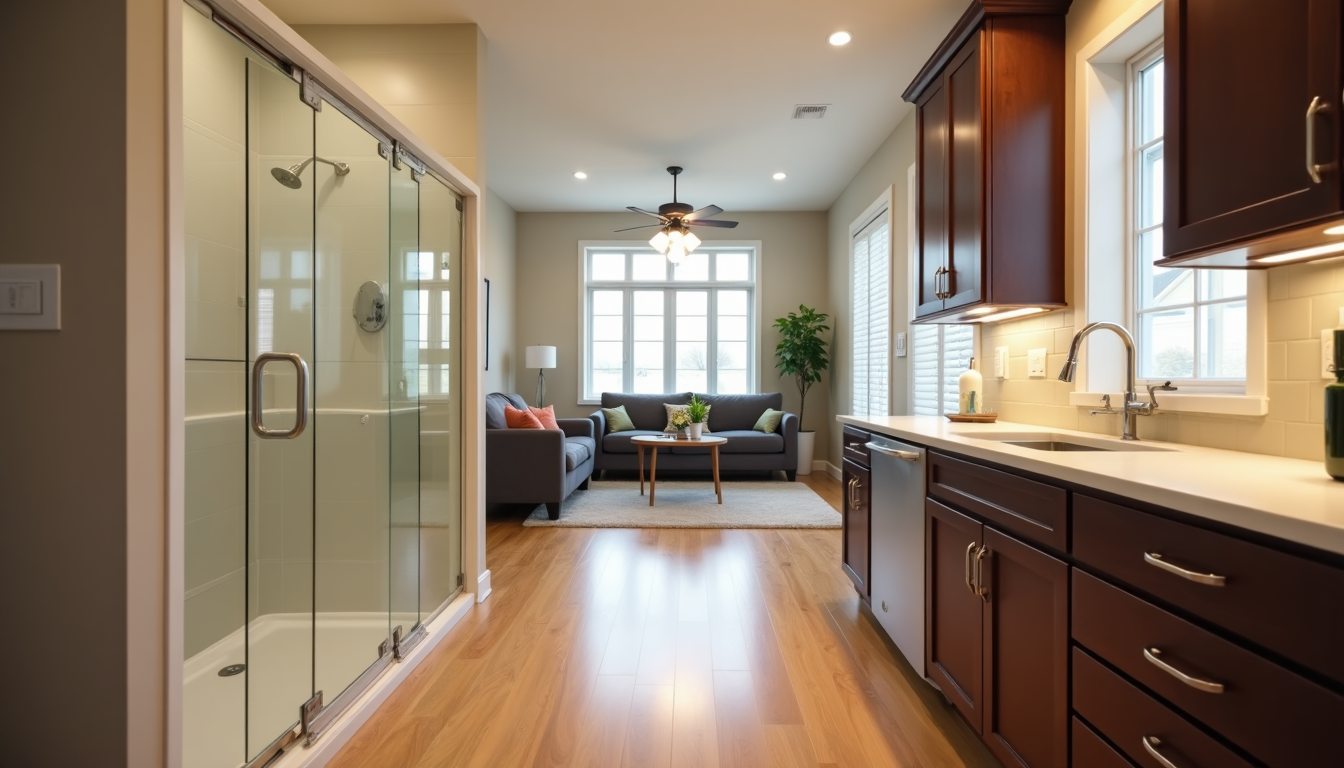As seniors age, maintaining their homes becomes increasingly challenging. Home repair assistance for seniors offers vital support, ensuring their living spaces remain safe, comfortable, and accessible. This crucial aid addresses various needs, from minor fixes to major renovations, helping older adults stay independent in their cherished homes for longer periods.
Government programs, non-profit organizations, and local resources provide a range of options to assist seniors with home repairs. These include free home repair assistance for seniors, home repair grants for disabled individuals, and federal grants for home repairs. This article explores the available programs, offers tips to apply for assistance, and highlights the importance of these resources in enhancing the quality of life for older adults.
Government Programs for Senior Home Repairs
The U.S. government offers several programs to help seniors with home repairs and improvements. These initiatives aim to make homes safer, more comfortable, and more accessible for older adults. Here are some key programs:
HUD Title 1 Property Improvement Loans
The Department of Housing and Urban Development (HUD) provides Title 1 Property Improvement Loans through FHA-approved lenders. These loans can be used for a wide range of home improvements that make a home “basically more livable and useful” 1. Seniors can borrow up to $25,000 for single-family home improvements, with loan terms up to 20 years 1. The program doesn’t require a minimum credit score or income, making it accessible to many seniors 1.
Section 504 Home Repair Program
Also known as the Single Family Housing Repair Loans & Grants, this program is managed by the U.S. Department of Agriculture (USDA). It’s designed to help very low-income homeowners in rural areas repair, improve, or modernize their homes 2. For seniors aged 62 or older who can’t afford a loan, grants of up to $10,000 are available to remove health and safety hazards 2. Loans and grants can be combined for up to $50,000 in assistance 2.
To qualify, applicants must: • Be the homeowner and occupy the house • Be unable to obtain affordable credit elsewhere • Have a household income below the very low limit for their area • For grants, be 62 years or older
Weatherization Assistance Program
The Weatherization Assistance Program (WAP) is a federal initiative that helps low-income households, including seniors, improve their home’s energy efficiency. This program can help reduce energy costs while making homes more comfortable and safe. Services may include:
• Adding insulation • Sealing air leaks • Repairing or replacing heating systems
To be eligible, households typically need to be at or below 200% of the poverty income guidelines or receive Supplemental Security Income 3. Priority is given to older adults, families with disabilities, and households with children 3.
These government programs offer valuable resources for seniors needing home repairs. They can help older adults maintain their independence and age in place safely. When considering these options, it’s important to research the specific requirements and application processes for each program. Local housing authorities or Area Agencies on Aging can often provide guidance on accessing these resources and finding the best fit for individual needs.
Non-Profit Organizations Offering Assistance
Non-profit organizations play a crucial role in providing home repair assistance for seniors. These organizations often fill gaps left by government programs and offer valuable support to older adults who need help maintaining their homes. Two notable non-profits that provide such assistance are Rebuilding Together and Habitat for Humanity.
Rebuilding Together
Rebuilding Together is a national non-profit organization that offers free home repairs and modifications to low-income homeowners, including older adults with fixed incomes. This organization brings together volunteers and skilled workers to help those who need it most. They provide a range of services, from small fixes to major renovations, with the goal of making homes safer and easier to use.
Rebuilding Together’s Safe at Home program is designed to help older adults remain safe, healthy, and independent in their homes and communities for as long as possible. This program provides no-cost preventive home modifications to people with mobility issues and other disabilities to improve accessibility, reduce falls, and facilitate aging in place.
The impact of Rebuilding Together’s work is significant. A 2019 program evaluation revealed that after receiving repairs, nearly 70% of all respondents felt they had a “low chance” or “no chance” of falling 4. Additionally, 91% of participants felt they would be able to age in place after receiving services, compared to 82% before 4.
Habitat for Humanity’s Home Preservation Program
Habitat for Humanity, known for building homes for those in need, also offers a Home Preservation Program that provides critical repairs for existing homeowners, including seniors. This program helps low-income homeowners with important home repairs through their Aging in Place initiative.
Habitat’s Aging in Place program enables low-income older adults to age safely in their homes and communities. Local Habitat affiliates collaborate with human services organizations to evaluate individual needs and provide home repairs, modifications, and community services specific to each homeowner’s lifestyle to preserve their home and independence 5.
The program offers a range of services, including:
• Critical home repairs • Safety modifications (e.g., installing grab bars, improved lighting) • Accessibility improvements (e.g., ramps, widened doorways) • Energy efficiency upgrades
Habitat’s approach is holistic, considering not just the physical aspects of the home but also the overall well-being of the homeowner. They partner with community-based social organizations to provide additional support, such as help with grocery shopping, meal preparation, and transportation to medical appointments 5.
To be eligible for Habitat’s Aging in Place services, homeowners typically need to be in their early- to mid-60s or older and considered low-income. However, specific age and income qualifications may vary by location, so it’s best to contact the local Habitat affiliate for details 5.
These non-profit organizations provide valuable resources for seniors needing home repairs, often complementing government programs and filling crucial gaps in assistance. Their work not only improves the physical condition of homes but also enhances the quality of life for older adults, allowing them to age in place with dignity and independence.
Local and State Resources for Senior Home Repairs
In addition to federal programs, many local and state resources are available to help seniors with home repairs. These resources often provide more targeted assistance, taking into account the specific needs of their communities.
Area Agencies on Aging
Area Agencies on Aging (AAA) are vital local resources that connect seniors with various services, including home repair assistance. These agencies serve as a bridge between older adults and the programs designed to help them age in place safely and comfortably.
AAAs often offer or can direct seniors to home repair programs funded by the Older Americans Act. These programs may provide grants or low-cost services for essential home modifications and repairs. For instance, the Area Agency on Aging District 7 in Ohio offers a home repair program for eligible older adults in their ten-county region 6.
Services provided through AAA-affiliated programs can include:
• Repair or replacement of heating systems • Plumbing system repairs • Roof, wall, floor, and door repairs • Installation of ramps for accessibility • Kitchen and bathroom modifications for improved safety
To be eligible for these programs, seniors typically need to meet certain criteria, such as being 60 years or older, owning their home, and having a household income at or below a specified threshold 6.
Community Development Block Grants
Community Development Block Grants (CDBG) are another valuable resource for senior home repairs. These grants, provided by the U.S. Department of Housing and Urban Development (HUD), are distributed to states, cities, and counties to support community development initiatives, including home repair assistance for low- and moderate-income residents 7.
CDBG funds can be used for various home repair activities, such as:
• Rehabilitation of residential structures • Improvements to water and sewer facilities • Energy conservation and renewable energy resources • Accessibility modifications
While HUD doesn’t provide CDBG assistance directly to individuals, seniors can benefit from these funds through local programs. To access CDBG-funded home repair assistance, older adults should contact their local municipal or county officials to learn about available programs in their area 7.
It’s important to note that each community has flexibility in how they use CDBG funds, so the specific home repair programs and eligibility requirements may vary from one location to another. However, all CDBG-funded activities must meet one of the program’s national objectives, which include benefiting low- and moderate-income persons or addressing urgent community development needs 7.
By tapping into these local and state resources, seniors can find additional avenues for home repair assistance beyond federal programs. These resources often provide more personalized support and may be better equipped to address the unique needs of their local senior population.
Tips for Applying for Home Repair Assistance
Applying for home repair assistance can be a complex process, but with the right approach, seniors can increase their chances of success. Here are some helpful tips to guide older adults through the application process for home repair programs.
Gather Required Documents
Before starting the application process, it’s crucial to collect all necessary documents. This preparation can save time and reduce stress during the application. Typically, programs require:
• Proof of identity: A government-issued photo ID and evidence of date of birth if not listed on the ID 8 • Income verification: The last two signed and filed Federal Income Tax Returns, including W-2 forms and 1099 forms 8 • Asset information: Two most recent asset/bank statements 8 • Property ownership proof: A copy of the deed or other documentation 8 • Property tax information: The most recent property tax assessment and annual statement 8
For seniors applying for grants, additional documentation may be needed to prove age eligibility. Some programs, like the USDA’s Section 504 Home Repair program, require applicants to be 62 years or older for grant eligibility 9.
Understand Eligibility Criteria
Each home repair assistance program has specific eligibility requirements. It’s essential to review these criteria carefully before applying. Common eligibility factors include:
• Age: Many programs are designed for seniors, often defining eligibility as 60 years or older 10 • Income: Most programs have income limits. For example, the USDA’s Section 504 program requires applicants to have a household income below the very low limit for their area 9 • Homeownership: Applicants typically must own and occupy their home as their primary residence 11 • Location: Some programs are specific to certain areas or have different criteria for rural and urban locations 8
Understanding these criteria can help seniors determine which programs they’re most likely to qualify for, saving time and effort in the application process.
When applying, it’s important to be thorough and accurate. Many programs report that incomplete applications are a common issue 12. Taking the time to fill out all required information and double-checking for accuracy can help avoid delays.
If the application process seems overwhelming, seniors shouldn’t hesitate to seek help. Many programs partner with local organizations that can assist with the intake process 12. Area Agencies on Aging can also be valuable resources, often offering guidance on available programs and application procedures.
Lastly, seniors should be prepared for potential wait times. Approval times can vary depending on funding availability and program demand 9. It’s a good idea to apply as soon as possible and to explore multiple options for assistance.
By following these tips and being well-prepared, seniors can navigate the application process for home repair assistance more effectively, increasing their chances of receiving the help they need to maintain safe and comfortable homes.
Conclusion
Home repair assistance programs play a crucial role in helping seniors maintain their independence and age in place safely. These initiatives, ranging from government programs to non-profit efforts and local resources, have a significant impact on improving the quality of life for older adults. By addressing various repair needs and making homes more accessible, these programs enable seniors to stay in their cherished homes longer, enhancing their comfort and well-being.
To make the most of these resources, seniors should gather all necessary documents, understand eligibility criteria, and apply to multiple programs if possible. The availability of such assistance underscores the importance of supporting our aging population and ensuring they have safe, comfortable living environments. As communities continue to recognize the value of these programs, we can hope to see more initiatives aimed at helping seniors maintain their homes and independence in the years to come.
FAQs
Currently, there are no frequently asked questions available related to the article on “Home Repair Assistance for Seniors: Programs and Resources.” Please refer to the main content for detailed information on various programs and resources available for senior home repairs.
References
[1] – https://www.nerdwallet.com/article/mortgages/fha-title-1-loans
[2] – https://www.rd.usda.gov/programs-services/single-family-housing-programs/single-family-housing-repair-loans-grants
[3] – https://www.energy.gov/scep/wap/how-apply-weatherization-assistance
[4] – https://rebuildingtogether.org/safe-at-home
[5] – https://www.habitat.org/our-work/aging-in-place/faq
[6] – http://www.aaa7.org/home-repair-program
[7] – https://www.hud.gov/program_offices/comm_planning/cdbg
[8] – https://www.rd.usda.gov/sites/default/files/504-Application.pdf
[9] – https://www.rd.usda.gov/programs-services/single-family-housing-programs/single-family-housing-repair-loans-grants-5
[10] – https://www.payingforseniorcare.com/new-york/restore-program
[11] – https://www.nyc.gov/site/hpd/services-and-information/homefix.page
[12] – https://nchh.org/resource-library/establishing-and-running-a-local-home-repair-program.pdf












